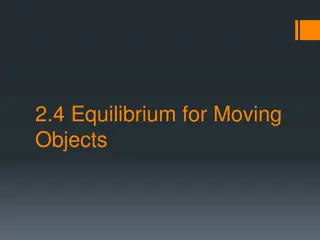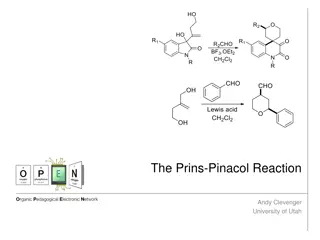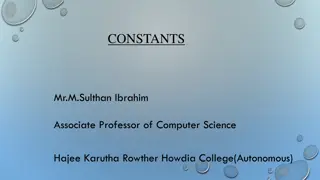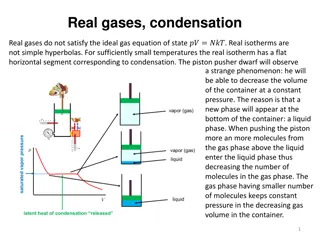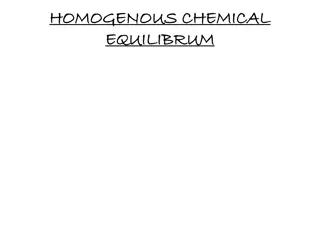Understanding Reaction Isotherms and Equilibrium Constants
Explore reaction isotherms and equilibrium constants through Vant Hoff's and Gibbs free energy equations. Learn about the relationship between Gibbs free energy, equilibrium constant, and temperature dependence. Discover how these concepts are applied in determining the direction of chemical reactions and calculating equilibrium constants.
Download Presentation

Please find below an Image/Link to download the presentation.
The content on the website is provided AS IS for your information and personal use only. It may not be sold, licensed, or shared on other websites without obtaining consent from the author. Download presentation by click this link. If you encounter any issues during the download, it is possible that the publisher has removed the file from their server.
E N D
Presentation Transcript
Reaction isotherm Name of the instructor:U.Nithya M.Sc.,M.Phil.,
Vant Haffs Reaction isotherm: Relation between Gibb s free energy G and equilium constant Kp: Derivation: consider a mixture of four ideal gases A,B,C and D. suppose the following reaction takes place aA + bB ------------- cC + dD The chemical potential of various gases are A = A+ RT ln PA B= B+ RT ln PB C= C+ RT ln PC D= D+ RT ln PD
The free energy change of the reaction G = (c c + d D) - (a A+ b B) G = (c C+ cRT ln PC+ d D+ dRT ln PD) (a A+ aRT ln PA+ b B+ bRT ln PB) G = (c c + d D) (cRT ln PC+ dRT ln PD) - (a A+ b B) (aRT ln PA+bRT ln PB) G = (c c + d D) - (a A+ b B) +RT ln PcCPdD/ PaAPbB G = G + RT ln PcCPdD/ PaAPbB---------------------- G is the free energy change of reaction If the reaction is at equilibrium G =0 0 = G + RT ln PcCPdD/ PaAPbB 1
G = -RT ln PcCPdD/ PaAPbB In this equation PcCPdD/ PaAPbBis known as equilibrium constant.It is denoted as Kp. G = -RT ln Kp-------------------------- 2 G - standard free energy change Kp. - depends on temperature only. It should not change with pressure. Applying 2 in 1 G = -RT ln Kp+ RT ln PcCPdD/ PaAPbB. --------------- 3 G = -RT ln Kp+ RT ln Ja ----------------------------------- G = -RT ln Kp+ RT ln. Qp----------------------------------- 4 5
Equations 3,4&5 are different form of reaction isotherm. Ja orQp= a function of the same form as Kp Applications: 1. It is difficult to determine G experimentally.It involves the measurements of standard enthalpy change and entropy change.But equilibrium constant can be easily determined.using van t hoff s isotherm We can calculate G frm the known value of Kp. 2. It is used to show the direction in which a reaction tends to proceed.
Vant Hoffs equation and vantHoffs isochore: Temperature-Dependence of equlibrium constant: when the temperature of a chemical equilibrium is altered there is change in the value of equilibrium constant. The temperature dependance of equilibrium constant is explained by van t Hoff s equation or Van t Hoff s reaction isochore. Derivation: consider van t Hoff isotherm for a chemical equilibrium G = -RT ln Kp Rearranging. ln Kp= - 1/R . G /T Differentiating with temperature dlnKp/dT = -1/R .d G /T/dT---------------------------- 1 According to Gibb s-helmholtz equation d G /T/dT = - H /T2
Substituting the value in equation 1 dlnKp/dT =- 1/R. H /T2 dlnKp/dT= H / RT2 This equation is known as van t Hoff isochore or van t Hoff s equation. H is standard enthalpy change for the chemical equation. If H is constant, van t Hoff isochore can be integrated. dlnKp= H / R . dT/T2 Integrating between limits lnkp1 lnkp2 dln Kp= H / R T1 T2 dT/T2 ln KP2/KP1= H / R [1/T1-1/T2] ln KP2/KP1= H / R [T1-T2/T1T2] This is the integrated form of van Hoff equation.
Discussion: From van t Hoff s isochore dln KP= H / R =dT/T2 H is negative for exothermic reactions. So rise in temperature down the equilibrium constant. H is positive for endothermic reactions.so rise in temperature increase the value of equilibrium constant. Application: if we know H and Kpat certain temperaturr value of Kpat another temerature can be easily calculated. For this calculation H and R should be expressed in the same unit.
Clapeyron equation: Derivation: For pure substance in a single phase the variation in chemical potential is given by the equation. d = - SdT + Vdp -------------------- 1 if we have an equilibrium between the two phases 1( = 1) and 2( = 2) at constant temperature (T) and Pressure (P) then. d =0 or. 1 = 2 Suppose we have two phases in equilibrium and that the pressure of the system is changed by dp. The equilibrium temperature will be changed by dT and the chemical potential will be changed by d . 1= 2; d 1=d 2
From equation 1 d 1 = -S1 dT +V1dP -------------------- 2 d 2= -S2dT +V2dP ------------------- 3 Since d 1 = d 2 -S1 dT +V1dP = -S2dT +V2dP S2dT - S1dT =V2dP+V1dP (S2-S1)dT =(V2-V1)dP S dT. = V dP dT/dP = V/ S -------------- 4 (or) dP/dT = S/ V ------------ 5 Equation 4 and 5 is called the clapeyron equation.
Applications: 1. Application to solid liquid equilibrium: This equilibrium is called melting or fusion. sfus= sliq- ssolid=+ve quantity Vfus= Vliq- Vsolid=+ve quantity for sustances like water vfus.is negative because the density of ice is less than the density of water. If we now change the pressure on the system from P1 and P2then the temperature at which equilibrium melting will occur is changed from T1to T2. It is observed that for an increase of 1atm pressure the increase in the melting Point is only 0.02deg. so it is observed that the effect of pressure on the melting point of a solid is not large. so small variations of pressure are neglected when melting point is considered.
2.Application to liquid gas equilibrium: This equilibrium is called boiling or vapourisation. svap= sliq- sgas=+ve quantity Vvap= Vliq- Vgas=+ve quantity At ordinary temperature and pressure it is observed that for an increase of 1atm. pressure the increase in the boiling point is about is about 25 c. Therefore the effect of pressure on the boiling oint is large. 3.Application of solid gas equilibrium: This equilibrium is called sublimation.
ssub= ssolid- sgas=+ve quantity Vsub= Vsolid- Vgas=+ve quantity So the clapeyron equation is dP/dT = s/ v = +ve/+ve =+ve Hence the effect of pressure on the sublimation temperature is also positive. At the condition when Hsub= Hfus+ Hvapthe three phases will be in equilibrium. This is called trile point.
Clapeyron clausius equation: Equation: log P2/P1= Hv/2.303 R [T2-T1] Derivation: dP/dT= S/ V. ---------------------- 1 S = Hv /T. -------------------------- 2 dP/dT = HV/ TV = Hv/ T(vgas-vliq) Vliqcan be neglected in comparison with Vgasso dP/dT = HV/ TV If the gas behaves ideally PV=RT. Or. V=RT/P So. dP/dT = HVP/ TRT lnP/dT = HV/ RT2. ---------------- 3 The equation(3) is called the clausius clapeyron equation.
The equation 3 can be integrated as follows: p1 p2 ln P = T1 T2 Hv/RT2dT ln P2/P1= Hv/R [ T2-T1/T1T2] log P2/P1= Hv/2.303R [ T2-T1/T1T2] This is integrated form of clausius clapeyron equation. Applications: => The clapeyron clausius equation can be used for calculating enthalpy of vapourisation Hvof a liquid if we know the values of vapour pressures at two temperatures. => Further if Hvis known vapour ptessure at any desired temperature can be calculated knowning the vaour pressure at a particular temperature.
=> This can also be used for calculating the effect of pressure on the boiling point of s liquid. => This equation is also used for the calculation of molar elevation constant and molal depression constant of a solvent. => The plot of log10P versus 1/T for any liquid gives a straight line. The slope of the curve gives Hv/2.303R. => For substances which obey troutons rule svap= Hvap/Tb~ 21 the Hvvalue can be calculated knowing the boiling Point alone. => This equation can be used for the determination of heat of fusion of a solid using the following form of the equation.
dP/dT = Hf/Tf(V1-V2) Where dP/dT is the rate of change of pressure with temperature. V1is the volume of the substance in liquid state V2the volume of the solid and Tfis the freezing oint of the solid.






